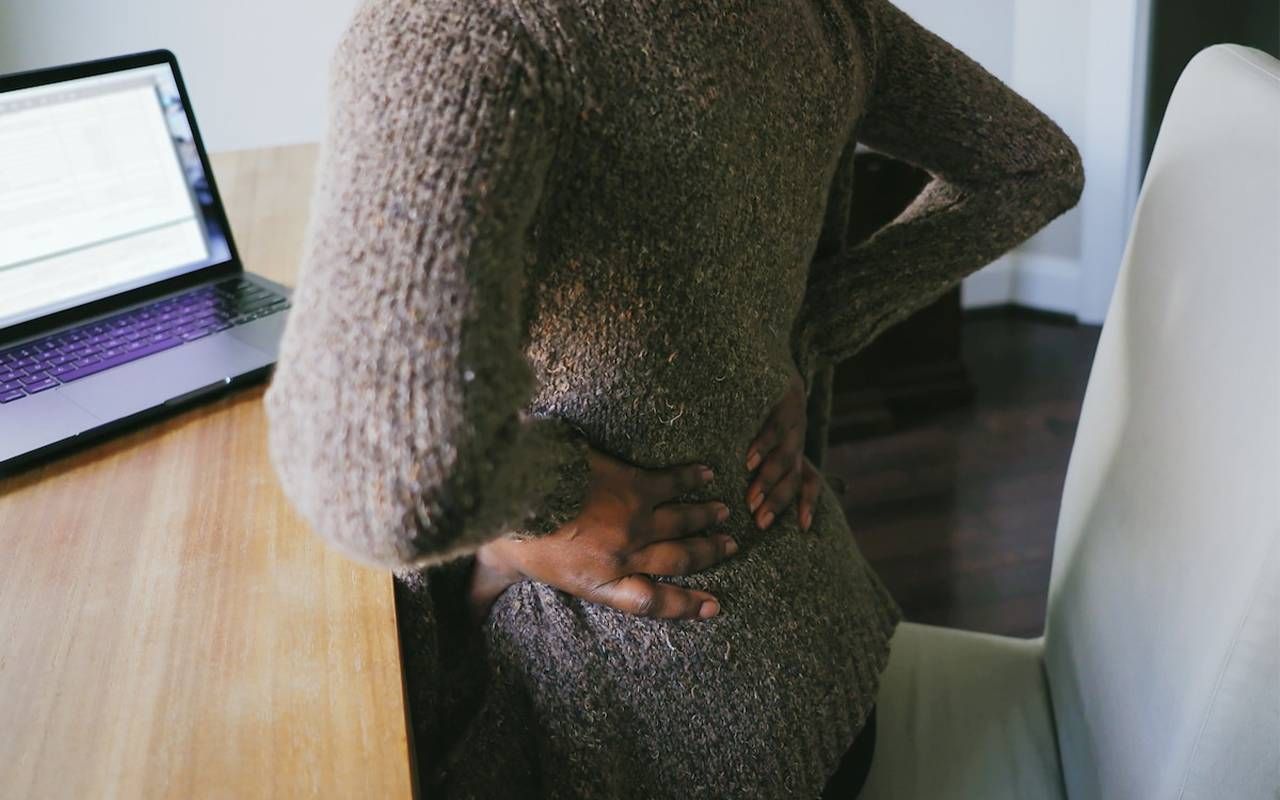The Pain of a Slipped Disc
A look into the identification, management and prevention of herniated discs in older adults
It was 3:30 am when I woke from a seemingly sound sleep with a pain intensity I had never experienced. I'm sure I screamed since the pain was so severe in my lower back and radiated down my left leg to my ankle. What was this from?

After I composed myself, I concluded that the pain was likely due to a bulging or herniated disc. As a nurse, I've had problems with my back for years, but no more than an "achiness" after a busy workday.
The pain was unrelenting, no matter what medication I took.
Usually, an ice pack, ibuprofen and a good night's sleep did the trick. But this time was different. Later that morning, I went to my family doctor, who prescribed me a cocktail of medication and confirmed that I likely had a herniated disc.
The pain was unrelenting, no matter what medication I took. A CT (computerized tomography) scan later established the diagnosis — a disc herniation at L4-L5 with evidence of degenerative disc disease.
What Is Disc Herniation?
You may have heard the terms slipped, herniated, bulging or prolapsed disc used interchangeably. Even though each may have a slightly different meaning, this usually references a herniated disc.
The spinal column's bony sections, called vertebrae, have flexible cushioning (disc) and connective tissue between each section. This cushioning protects the spinal cord and nerves by acting as shock absorbers.
The middle of the disc is like jelly with a tough exterior (annulus). Thus, herniation occurs when the middle discs protrude through a tear in the annulus. Sometimes the protrusion causes no symptoms and is only picked up on imaging such as X-ray, CT or MRI (Magnetic Resonance Imaging).
However, when herniation causes pressure on the nerves, the result is extreme pain, tingling, numbness or weakness in the affected arm or leg. Disc herniation may occur anywhere along the spinal column. Still, the lower back (lumbar) is most common, but it may also occur in the cervical area (neck).
What Are the Causes?
A herniated disc may be due to trauma from a sudden thrust in contact sports, heavy lifting or twisting while lifting. Older adults are at a high risk of disc herniation because their discs gradually degenerate and become less flexible.
A herniation can occur following a significant event or, in my case, "out of the blue." In addition, other factors place someone at a higher risk of having a herniated disc:
- Occupational hazards: People who have worked at jobs where they must lift, twist and bend repeatedly. Construction workers, truck drivers, health care and factory workers, to name a few.
- Smoking: Reduced oxygen to the spinal tissue due to smoking makes it more fragile.
- Genetics: Often, there is a family history of back problems.
- Weight: Being overweight strains the spine, puts pressure on the discs and increases degeneration.
- Sedentary lifestyle: Muscle weakness from inactivity, especially in the back and abdominal areas.
I hope to be one of the many who do not require surgical intervention, but I now feel better informed.
Symptoms
These depend on the area and severity of the herniation. Some people may have no signs or a slightly lower back "ache." Others may have symptoms of greater intensity:
- Leg, arm or shoulder pain, usually only on one side of the body
- A tingling sensation or numbness (paresthesia) in the affected limb(s). Sciatic pain is usually in one side of the body, from the buttocks to the hips or legs.
Symptoms requiring prompt medical attention include:
- Weakness, diminished reflexes, or paralysis in the affected limb
- Bowel or bladder incontinence
- "Cauda equina syndrome," occurs due to nerve root compression, causing sensation and movement loss
- "Saddle anesthesia" is loss of sensation in the inner thighs, around the rectum or back of the legs
Diagnosis and Treatment
If you have any of the above symptoms, you must see your health care provider (HCP) for a physical assessment and diagnosis. They can provide you with analgesics for the pain, usually NSAIDs (non-steroidal anti-inflammatory drugs,) sometimes opioids, muscle relaxants and recommendations for physical therapies. X-ray, CT, and MRI are other diagnostic tools to confirm the diagnosis.
Most people with disc herniation choose conservative treatment through rest, NSAIDs, and physical therapy. Additionally, treatments may include ultrasound, cold packs and TENS (Transcutaneous Electrical Nerve Stimulation.) Other alternative therapies may consist of spinal decompression and osteopathic care.
Furthermore, some people choose steroidal injection into the spinal area of the herniation for pain management. Finally, some people choose gentle chiropractic care, but most experts caution against spinal manipulation.
In more severe cases, surgical intervention may be necessary when significant neurological deficits and uncontrolled pain affect a person's quality of life. Surgical options include:
- Laminectomy: The removal of some or all vertebral bones (lamina) to relieve pressure on the affected nerve.
- Discectomy: The removal of the damaged portion of the herniated disc.
- Artificial disc surgery: The removal of the damaged disc and replacement with a prosthetic disc to maintain spinal motion.
- Spinal fusion: When two or more vertebrae are fused to reduce pain-causing motion.
Prevention and Lifestyle Modifications
No matter your age, maintaining your best health is the key factor to preventing disc herniation or other chronic illnesses. Recovery from a disc herniation will include some of these practices once you have authorization from your HCP to increase activity.
No matter your age, practicing a healthy diet and exercise will most certainly benefit your spinal and overall health.
- Gentle stretching: To strengthen the back muscles. Consider yoga or Pilates. Gentle stretching will also help you maintain a good posture to reduce pressure on the spine and discs. Use good body mechanics when lifting (use your legs and not your back) and seek assistance when lifting heavier objects.
- Exercise to maintain overall strength and achieve/maintain a healthy weight. Walking is free and relatively easy to start. Consider using walking poles to increase calorie expenditure and assist with balance. Many communities have walking groups; if you can't find one, create one of your own. Activity in the context of a community will often motivate you and keep you accountable.
- Maintain a healthy weight. Exercise will help you achieve or maintain a healthy weight, but healthy dietary habits will also help ensure optimal health. Eat more fresh fruits and vegetables, including foods with high fiber, such as whole grains, nuts and seeds. Avoid processed and fast foods. Eat less red meat, consider more fish, such as salmon, and consume adequate protein for tissue repair. You can consult a registered dietician to provide you with guidance.
- Consider vitamins or nutritional supplements. Studies have shown low vitamin D levels in people with disc herniation so supplementation may be advisable. Consider vitamins C, E and K; nutritional supplements may include Omega-3 fatty acids, magnesium, glucosamine, and chondroitin to support health. Still, you must consult your HCP to ensure you take the right supplements based on your medical history and current medications.
As for my case, I am still in recovery with conservative approaches, including physical therapy and NSAIDs. I hope to be one of the many who do not require surgical intervention, but I now feel better informed.
If you have symptoms suggesting you may have a herniated disc, see your HCP as soon as possible. Early diagnosis and treatment will help to increase your odds of better health and well-being.


